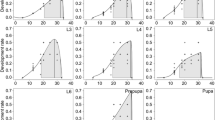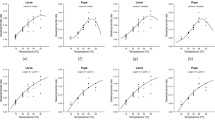Abstract
Corn stem borer, Sesamia cretica Lederer is an important pest of corn and sugarcane across the globe. The development rate and thermal constant of S. cretica were determined at ten constant temperatures ranging from 12 to 36 (± 1) °C, 50 ± 10% RH and a photoperiod of 16:8 (L:D) h for the Varamin and Rey populations of the pest in laboratory conditions. Two linear models (ordinary and Ikemoto) were used to determine the lower temperature threshold (T0) and thermal constant (K) of different stages of the pest. Furthermore, the development rate at different temperatures fitted to 26 nonlinear models. No eggs were hatched at 12 °C and only the incubation period was completed at 15, 35, and 36 °C with a significant difference between the two populations. The data of both populations better fitted to the Ikemoto linear model and it estimated T0 of the total immature stages to be 14.11 °C and 13.57 °C for the Varamin and Rey populations, respectively. The K value for the egg, larvae, pupa, and the total immature stages were estimated to be 72.74, 586.88, 141.33, and 895.36 DD in the Varamin population and 79.05, 804.36, 145.28, and 945.10 DD in the Rey population, respectively. Validation assessment of the linear and nonlinear models picked up based on Akaike information criterion (AIC) of the total immature stages showed that the development time estimated by the linear (Ikemoto) and nonlinear (Briere-1) models were close to the observed development time for the Varamin and Rey populations at the fastest developmental temperature in laboratory condition. These findings can be used to construct a forecasting model for appropriate control of S. cretica.


Similar content being viewed by others
References
Akaike H (1974) A new look at the statistical model identification. IEEE Trans Autom Control 19:716–723
Al-Allan MA (2009) Biological and ecological study for noctuid corn stem borer Sesamia cretica Lederer (Lepidoptera: Noctuidae) in Syria. PhD thesis, Faculty of Agriculture- Damascus University
Allahyari H (2005) Decision making with degree-day in control program of Colorado potato beetle. University of Tehran, Tehran, Iran, Ph.D
Analytis S (1977) Über die Relation zwischen biologischer Entwicklung und Temperatur bei phytopathogenen Pilzen. J Phytopathol 90:64–76
Analytis S (1980) Obtaining of sub-models for modeling the entire life cycle of a pathogen. J Plant Dis Prot 87:371–382
Arbabtafti R, Fathipour Y, Ranjbar Aghdam H (2021) Population fluctuation and spatial distribution pattern of Sesamia cretica (Lepidoptera: Noctuidae) in Southeastern Tehran, Iran. J Agric Sci Technol 23:371–385
Briere JF, Pracros P, Le Roux AY, Pierre S (1999) A novel rate model of temperature dependent development for arthropods. Environ Entomol 28:22–29
Burnham KP, Anderson DR, Huyvaert KP (2011) AIC model selection and multimodel inference in behavioral ecology: some background, observations, and comparisons. Behav Ecol Sociobiol 65:23–35
Campbell A, Frazer BD, Gilbert N, Gutierrez AP, Mackauer M (1974) Temperature requirements of some aphids and their parasites. J Appl Ecol 11:431–438
Davidson J (1942) On the speed of development of insect eggs at constant temperatures. Aust J Exp Biol Med Sci 20:233–239
Davidson J (1944) On the relationship between temperature and rate of development of insects at constant temperatures. J Anim Ecol 13:26–38
Friedman J, Bohonak AJ, Levine A (2013) When are two pieces better than one: fitting and testing OLS and RMA regressions? Environmetric 24:306–316
Goftishu M, Assefa Y, Fininsa C, Niba A, Capdevielle-Dulac C, Le Ru BP (2016) Phylogeography of Sesamia cretica Lederer (Lepidoptera: Noctuidae). Phytoparasitica 44:641–650
Golizadeh A, Kamali K, Fathipour Y, Abbasipour H (2007) Temperature-dependent development of diamondback moth, Plutella xylostella (Lepidoptera: Plutellidae) on two brassicaceous host plants. Insect Sci 14:309–316
Harcourt D, Yee J (1982) Polynomial algorithm for predicting the duration of insect life stages. Environ Entomol 11:581–584
Hilbert D, Logan J (1983) Empirical model of nymphal development for the migratory grasshopper, Melanoplus sanguinipes (Orthoptera: Acrididae). Environ Entomol 12:1–5
Honek A (1996a) Geographical variation in thermal requirements for insect development. Eur J Entomol 93(3):303–312
Honek A (1996b) The relationship between thermal constants for insect development: a verification. Acta Soc Zool Bohem 60:115–152
Honek A, Kocourek F (1988) Thermal requirements for development of aphidophagous Coccinellidae (Coleoptera), Chrysopidae, Hemerobiidae (Neuroptera), and Syrphidae (Diptera): some general trends. Oecologia 76:455–460
Honek A, Kocourek F (1990) Temperature and development time in insects: A general relationship between thermal constants. Zoologische Jahrbücher / Abteilung Für Systematik 117(4):401–439
Janisch E (1932) The influence of temperature on the life-history of insects. R Entomol Soc London 80:137–168
Ikemoto T (2005) Intrinsic optimum temperature for development of insects and mites. Environ Entomol 34:1377–1387
Ikemoto T (2008) Tropical malaria does not mean hot environments. J Med Entomol 45:963–969
Ikemoto T, Takai K (2000) A new linearized formula for the law of total effective temperature and the evaluation of line-fitting methods with both variables subject to error. Environ Entomol 29:671–682
Ikemoto T, Kiritani K (2019) Novel method of specifying low and high threshold temperatures using thermodynamic SSI model of insect development. Environ Entomol 48(3):479–488
Kiritani K (2013) Different effects of climate change on the population dynamics of insects. Appl Entomol Zool 48:97–104
Kontodimas DC, Eliopoulos PA, Stathas GJ, Economou LP (2004) Comparative temperature-dependent development of Nephus includens (Kirsch) and Nephus bisignatus (Boheman) (Coleoptera: Coccinellidae) preying on Planococcus citri (Risso) (Homoptera: Pseudococcidae): evaluation of a linear and various nonlinear models using specific criteria. Environ Entomol 33:1–11
Lactin DJ, Holliday N, Johnson D, Craigen R (1995) Improved rate model of temperature-dependent development by arthropods. Environ Entomol 24:68–75
Ladanyi M, Horvath L (2010) A review of the potential climate change impact on insect populations-General and agricultural aspects. Appl Ecol Environ Res 8:143–152
Lee JH, Elliott NC (1998) Comparison of developmental responses to temperature in Aphelinus asychis (Walker) from two different geographic regions. Southwest Entomol 23:77–82
Logan J, Wollkind D, Hoyt S, Tanigoshi L (1976) An analytic model for description of temperature dependent rate phenomena in arthropods. Environ Entomol 5:1133–1140
Mirhosseini MA, Fathipour Y, Reddy GVP (2017) Arthropod development’s response to temperature: A review and new software for modeling. Ann Entomol Soc Am 110:507–520
Mirhosseini MA, Fathipour Y, Soufbaf M, Reddy GVP (2018) Thermal Requirements and Development Response to Constant Temperatures by Nesidiocoris tenuis (Hemiptera: Miridae), and Implications for Biological Control. Environ Entomol 47(2):467–476
Pakyari H, Fathipour Y, Enkegaard A (2011) Effect of temperature on life table parameters of predatory thrips Scolothrips longicornis (Thysanoptera: Thripidae) fed on two spotted spider mites (Acari: Tetranychidae). J Econ Entomol 104:799–805
Pradhan S (1945) Insect population studies. II. Rate of insect development under variable temperature of the field. Proc Natl Acad Sci India 11:74–80
Ratkowsky D, Lowry R, McMeekin T, Stokes A, Chandler R (1983) Model for bacterial culture growth rate throughout the entire biokinetic temperature range. J Bacteriol 154:1222–1226
Rebaudo F, Rabhi VB (2018) Modeling temperature-dependent development rate and phenology in insects: review of major developments, challenges, and future directions. Netherlands Entomol Soc Entomol Exp Appl 166:607–617
Rochat J, Gutierrez AP (2001) Weather mediated regulation of olive scale by two parasitoids. J Anim Ecol 70:476–490
Roy M, Brodeur J, Cloutier C (2002) Relationship between temperature and developmental rate of Stethorus punctillum (Coleoptera: Coccinellidae) and its prey Tetranychus mcdanieli (Acarina:Tetranychidae). Environ Entomol 31:177–187
Schoolfield R, Sharpe P, Magnuson C (1981) Non-linear regression of biological temperature-dependent rate models based on absolute reaction-rate theory. J Theor Biol 88:719–731
Sharpe PJ, DeMichele DW (1977) Reaction kinetics of poikilotherm development. J Theor Biol 64:649–670
Shi P, Ge F, Sun Y, Chen C (2011) A simple model for describing the effect of temperature on insect developmental rate. J Asia-Pac Entomol 14:15–20
Skendžić S, Zovko M, Živković IP, Lešić V, Lemić D (2021) The impact of climate change on agricultural insect pests. Insects 12:440. https://doi.org/10.3390/insects12050440
Smith RJ (2009) Use and misuse of the reduced major axis for line fitting. Am J Phys Antropol 140:476–486
Soltani Orang F, Ranjbar Aghdam H, Abbasipour H, Askarianzadeh A (2014) Effect of Temperature on Developmental Rate of Sesamia cretica (Lepidoptera: Noctuidae) Immature Stages. J Insect Sci 14:197
Somme L (1982) Supercooling and winter survival in terrestrial arthropods. Comp Biochem Physiol 73A:519–543
Taylor F (1981) Ecology and evolution of physiological time in insects. Am Nat 117:1–23
Temerak SA, Negm AA (1979) Impact and different effect of certain biomortality factors on the effect and newly-hatched larvae of the pink borer Sesamia cretica Led. on two sugarcane varieties. Z Angew Entomol 88:313–318
Trudgill DL (1995) Why do tropical poikilothermic organisms tend to have higher threshold temperatures for development than temperate ones. Funct Ecol 9:136–137
Trudgill DL, Perry JN (1994) Thermal time and ecological strategies - a unifying hypothesis. Ann Appl Biol 125:521–532
Wagner TL, Wu HI, Sharpe PJH, Schoolfield RM, Coulson RN (1984) Modeling insect development rates: a literature review and application of a biophysical model. Ann Entomol Soc Am 77:208–225
Wang R, Lan Z, Ding Y (1982) Studies on mathematical models of the relationship between insect development and temperature. Acta Ecol Sin 2:47–57
Worner SP (2008) Bioclimatic models in entomology, pp. 476–481. In: Capinera, J. L. (ed.) Encyclopedia of Entomology. Springer, Dordrecht, The Netherlands
Yamamura K, Kiritani K (1998) A simple method to estimate the potential increase in the number of generations under global warming in temperate zones. Appl Entomol Zool 33:289–298
Yazdanpanah S, Fathipour Y, Riahi E, Zalucki MP (2022) Modeling temperature-dependent development rate of Neoseiulus cucumeris (Acari: Phytoseiidae) fed on two alternative diets. Environ Entomol 51:145–152
Yin X, Kropff MJ, McLaren G, Visperas RM (1995) A nonlinear model for crop development as a function of temperature. Agric for Meteorol 77:1–16
Yukawa J (2000) Synchronization of gallers with host plant phenology. Popul Ecol 42:105–113
Yukawa J, Kiritani K, Gyoutoku N, Uechi N, Yamaguchi D, Kamitani S (2007) Distribution range shift of two allied species, Nezara viridula and N. antennata (Hemiptera: Pentatomidae), in Japan, possibly due to global warming. Appl Entomol Zool 42:205–215
Zahiri B, Fathipour Y, Khanjani M, Moharramipour S, Zalucki MP (2010) Preimaginal development response to constant temperatures in Hypera postica (Coleoptera: Curculionidae): picking the best model. Environ Entomol 39:177–189
Acknowledgements
The financial and technical support of this research by Department of Entomology, Tarbiat Modares University, and Iranian Research Institute of Plant Protection, is greatly appreciated.
Author information
Authors and Affiliations
Corresponding author
Ethics declarations
Conflicts of interest
All authors declare that they have no conflicts of interest.
Additional information
Publisher's Note
Springer Nature remains neutral with regard to jurisdictional claims in published maps and institutional affiliations.
Rights and permissions
Springer Nature or its licensor (e.g. a society or other partner) holds exclusive rights to this article under a publishing agreement with the author(s) or other rightsholder(s); author self-archiving of the accepted manuscript version of this article is solely governed by the terms of such publishing agreement and applicable law.
About this article
Cite this article
Arbabtafti, R., Fathipour, Y. & Aghdam, H.R. Thermal requirements and development response to constant temperatures by Sesamia cretica (Lepidoptera: Noctuidae). Int J Trop Insect Sci 43, 561–579 (2023). https://doi.org/10.1007/s42690-023-00958-z
Received:
Accepted:
Published:
Issue Date:
DOI: https://doi.org/10.1007/s42690-023-00958-z




